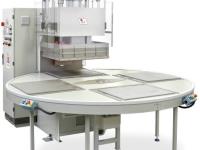 Add My Company
Add My Company
Sign In
What is high frequency welding?
10-02-2016

High frequency welding (often abbreviated HF welding or RF welding) is a manufacturing process where two plastic parts are welded together using an electromagnetic field.
Common products manufactured with high frequency welding are tarpaulins, tents, ceilings, advertising banners, waterbeds, inflatable boats, medical and especially blood and urine-bags, tensile structures, conveyor belts, rain clothing etc.
Principle and advantage of high frequency welding
The main principle of high frequency welding (HF welding) is based on di-electric heating of the material to be welded.
The objects that needs to be welded are clamped together between two metal electrodes and a high frequency voltage is supplied. As a result the molecyles in the material starts to vibrate and heat up. Eventually the material will melt, and the force supplied by the electrode will melt (fuse) the two surfaces together. After cooling a permanent seam has been created. The resulting weld seam can be as strong - or even stronger - than the surrounding material.
The great advantage of HF welding is the speed of welding: The material is heated from the inside and fuses quickly, within few seconds.
Compared to high frequency welding, a lot of other methods (hot air, infrared radiation, laser) the energy /heat is supplied from the outside. This means that the heat must first penetrate the material in order to heat the contact-surfaces, thus risking to burn the top layer of the welded material.
You could compare this to heating your food in the microwave oven vs in a traditional oven.
What materials can be HF welded?
The material most common in High frequency welding is PVC (sometimes called simply vinyl) and PU (Polyurethane). The material can be thick or thin, reinforced or coated. It can also be plain, coloured or structures / patterened.
Observe that bonding requires the two materials to flow and mix easily. Thus PVC materials can be welded with PVC components and PUR sheets needs special PUR components. Carmo has developed a unique PVC/PUR material that maintain a lot of the properties of the PVC and still allow for good bonding on PUR based foils and sheets.
What are the main parts involved in HF welding?
The three main parts involved in High frequency welding are:
•HF generator
•welding machine
•electrode
What are the important factors for high frequency welding?
The four most importent factors / process parameters influence High frequency welding are
•Electrical power
•Pressure applied
•Welding time
•Cooling time
Finding the optimal process parameters will depend on your specific equipment, the materials involved and the specific geometries including thichkness and area to be welded.
For more information on What is high frequency welding? talk to RH Plastics Technology Ltd
Enquire Now
List your company on FindTheNeedle.
